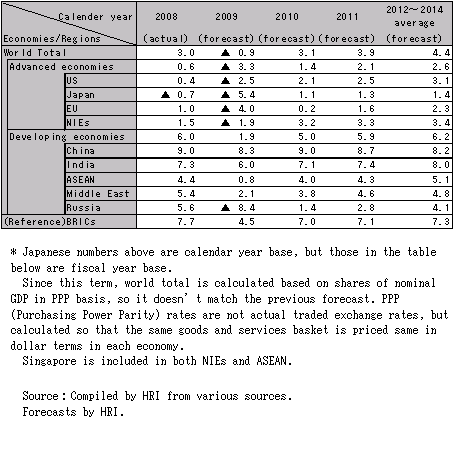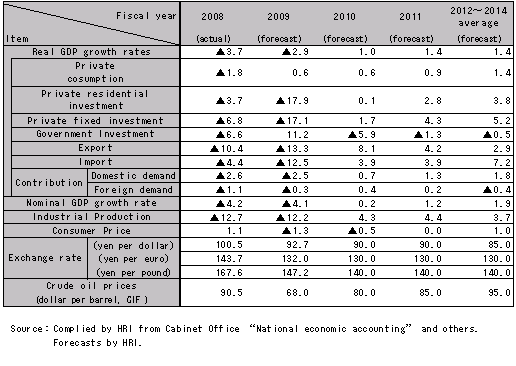Latest economic forecasts for Japan, the U.S., Europe, and China, etc
The world economy has avoided a complete fall into the "Once in a hundred years" great recession primarily through the policy coordination of the countries in the G20. But the economy is still weak, and depends heavily on economic stimulus. Moreover, the financial system, which seemed to be gradually recovering, was exposed to the Dubai Shock in November, once again demonstrating its vulnerability to financial crises. While the real and financial economy remain unstable, there is still a risk that speculative money will again flow into oil and other investments. Given all of these events, a new economic structure is becoming increasingly apparent in the post financial crisis period. The world economy will not simply recover after the crisis, but rather, the economic structure itself has changed compared to the pre- and post-crisis environment.
The structural cause of the crisis are global imbalances due to over consumption in the US, and excessive savings in China. Flows in the world economy will redress these imbalances. In this process, adjustment of the emerging markets’ foreign exchange rates seems to be the first structural change. Just as Japan experienced a steep appreciation of the Yen in the 1980s, the Chinese Yuan, in particular, will be put under strong pressure in the future. Coupled with a weak dollar, the current order of world foreign exchange will change.
The another major imbalance to redress is over consumption in the US. Consumption in US households will continue to be restrained as consumers make adjustments to their balance sheets. As these imbalances adjust, the level of economic growth will be slower than the level of economic activity before the crisis. Employment and income growth will be slower during this period of adjustment.
In European, the toxic asset problem and employment rates continue to deteriorate. The economic slow down in the Middle and Eastern European economies is at a critical level, and the fiscal deficit of Southern Europe is growing.
Despite the economic slow down in developed countries, the emerging markets, such as China and India, will lead growth in the world economy. China currently seems to be at the phase of doubling its income, just like Japan doubled its income during its high economic growth period. As incomes rapidly rise, China’s economic structure will increasingly evolve into a domestic demand oriented economy. The diffusion of high value durable goods, such as automobiles, will increase, and economic development of China’s heartland will increase. Of course risks do exist. Excessive investment, over supply, and insufficient development of its social and welfare infrastructure may push households more towards increasing their savings as a precautionary measure. The governmental policy towards foreign exchange may result in excessive liquidity, and an asset bubble may occur. There are risks in the emerging markets. But, their rapid growth means that a large market for social infrastructure will be created in order to support the large populations in these markets. There will be pressure on resource demand, and environmental protection may restrain economic growth. The growth of emerging markets will bring both opportunities and risks for the world economy.
Through the shift of political power, the Japanese economy faces challenges in making an economic recovery, and the population will continue to decrease. The policy shift from an emphasis on investment in concrete to an investment in people is under way. There still seems to be a GDP gap about 3 percent in Fiscal Year 2014. Consumer taxes are expected to rise from 5% to 8% in 2014 as a result of higher fiscal deficits caused by higher costs in the medical system and increased welfare burden.
Japan’s new growth strategy will focus on leveraging its proximity to the rapidly growing Asia markets, while trying to resolve "new global issues" of the environment, urban development, and declining birth rates.

